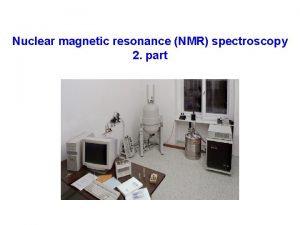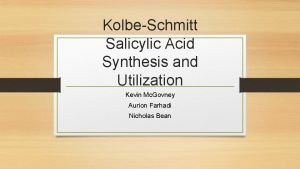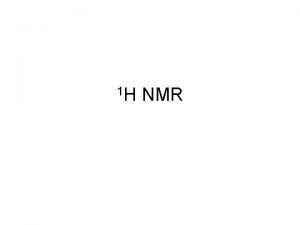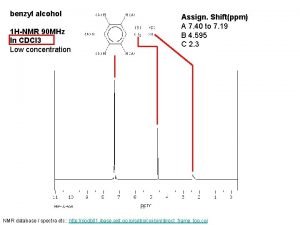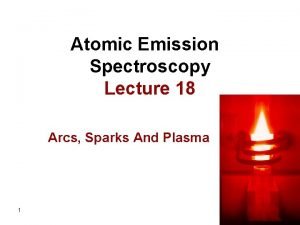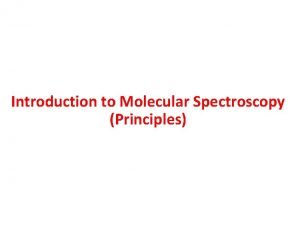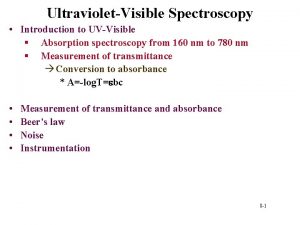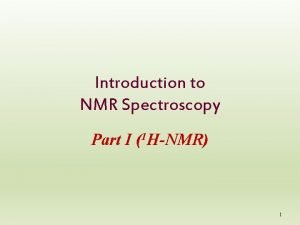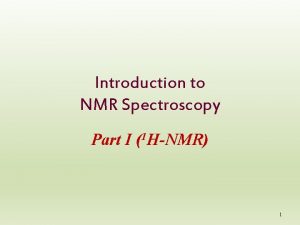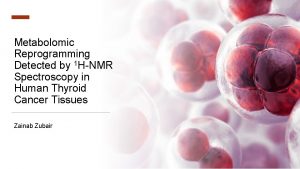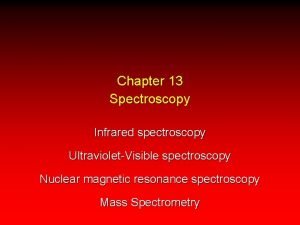Lecture 5 c Introduction 1 HNMR spectroscopy is










- Slides: 10

Lecture 5 c

Introduction • 1 H-NMR spectroscopy is used to determine the structure of the epoxide based on characteristic splitting patterns in the aromatic range and the epoxide range • When analyzing the spectrum, it will become much more difficult if the submitted sample is a mixture of many compounds i. e. , epoxide, aldehyde, water (d=1. 56 ppm), ethyl acetate (d=1. 26 ppm, 2. 05 ppm and 4. 12 ppm), hexane (d=0. 88 ppm, 1. 26 ppm), etc. (see SKR, p. 284) • The proton spectrum will exhibit a singlet at d=7. 26 ppm due to the presence of CDCl 3 if the concentration of the epoxide is very low • The carbon spectrum will show a “triplet” at d=77 ppm due to the presence of CDCl 3

4 -Methylstyrene oxide • 1 H-NMR Spectrum (integration in blue) 4 J 3 H 1 -H 2 H 1 -H 3 H 2 -H 3 3. 31 Hz 3. 30 Hz 5. 68 Hz 3 1 11 H 1, dd H 2, dd H 3, dd CH 3

4 -Methylstyrene oxide • 13 C{1 H}-NMR Spectrum • Seven signals total • Epoxide carbons at ~ 50 -60 ppm • Four signals in the aromatic range • The size of the peak for CDCl 3 depends on the concentration of the sample CDCl 3

4 -Methylbenzacetaldehyde • 1 H-NMR Spectrum (J 3(CH 2 -CHO)= 2. 56 Hz) CHO, “s” CH 3 1 3 CH 2, “s” 2 4

4 -Methylbenzacetaldehyde • 13 C{1 H}-NMR Spectrum • Aldehyde: ~200 ppm • Methylene: 45 -50 ppm • Methyl group: ~30 ppm CHO CH 2 CDCl 3 CH 3

4 -Methylacetophenone • 1 H-NMR Spectrum • Two doublets in the aromatic range, one of then significantly shifted downfield due to the adjacent carbonyl function • Two singlets in the d= 2 -2. 5 ppm range due to the two methyl groups 3 2 2 3

4 -Methylacetophenone • 13 C{1 H}-NMR Spectrum • Carbonyl: ~195 ppm (small) • Methyl groups: 20 -30 ppm CH 3 CDCl 3 CO

What is that? • Interpret the following 1 H-NMR Spectrum

How about that one? • Interpret the following 13 C{1 H}-NMR Spectrum spectrum
 Hnmr example
Hnmr example Salicylic acid hnmr
Salicylic acid hnmr Hexane h nmr
Hexane h nmr Benzyl alcohol nmr
Benzyl alcohol nmr Atomic emission spectroscopy lecture notes
Atomic emission spectroscopy lecture notes 01:640:244 lecture notes - lecture 15: plat, idah, farad
01:640:244 lecture notes - lecture 15: plat, idah, farad Applications of uv spectroscopy
Applications of uv spectroscopy Charge d'un électron
Charge d'un électron Introduction to biochemistry lecture notes
Introduction to biochemistry lecture notes Introduction to psychology lecture
Introduction to psychology lecture Introduction to algorithms lecture notes
Introduction to algorithms lecture notes
